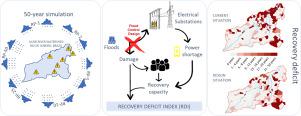当前位置:
X-MOL 学术
›
Energy Rep.
›
论文详情
Our official English website, www.x-mol.net, welcomes your
feedback! (Note: you will need to create a separate account there.)
A new approach to assess cascading effects of urban floods
Energy Reports ( IF 4.7 ) Pub Date : 2021-08-19 , DOI: 10.1016/j.egyr.2021.07.047 L.F. Guimarães 1 , B.P. Battemarco 1 , A.K.B. Oliveira 1 , M.G. Miguez 1, 2, 3
Energy Reports ( IF 4.7 ) Pub Date : 2021-08-19 , DOI: 10.1016/j.egyr.2021.07.047 L.F. Guimarães 1 , B.P. Battemarco 1 , A.K.B. Oliveira 1 , M.G. Miguez 1, 2, 3
Affiliation

|
The occurrence of floods has always represented a challenge to cities, with long-term impacts that are usually neglected, such as the degradation of the urban environment and the impoverishment of the population due to recurrent events. Besides the losses usually computed in flood damage assessment, there are also secondary effects, but not less important, resulting from failures of critical infrastructures, such as power supply, which generate diseconomies to the system. Thus, power outage can aggravate the effects of floods, reducing income generation, and consequently the population’s recovery capacity. Going beyond the “domino effect” metaphor, in which the disruption of a system can cause a chain of similar events disrupting other systems, this paper aims to expand the concept of cascading effects by considering not only the spatial approach that affects other urban services, but also incorporating temporal analysis. The main purpose, in this case, is to identify regions in which flooding is a catalyst for social impoverishment. Through hydrological and hydraulic modeling, the cascading effects can be interpreted as a series of interconnected events that are triggered by flood events and aggravated by their recurrence, what make it difficult or even impossible to recover from losses. The main innovation of the approach is the proposition of a global index to assess the watershed recovery deficit considering a sequence of flood events. Moreover, the results highlight that although the direct impacts of floods are more significant, the impact of power shortage worsens the societal situation.
中文翻译:

评估城市洪水连锁效应的新方法
洪水的发生一直是对城市的挑战,其长期影响通常被忽视,例如由于反复发生的事件导致城市环境恶化和人口贫困。除了洪水损失评估中通常计算的损失外,还存在因关键基础设施(例如电力供应)故障而产生的次要影响,但也同样重要,这会给系统带来不经济性。因此,停电会加剧洪水的影响,减少收入,从而降低人们的恢复能力。本文超越了“多米诺骨牌效应”的比喻,即一个系统的破坏可能会导致一系列类似的事件扰乱其他系统,本文旨在扩展级联效应的概念,不仅考虑影响其他城市服务的空间方法,而且还结合了时间分析。在这种情况下,主要目的是确定洪水是社会贫困催化剂的地区。通过水文和水力模型,级联效应可以解释为一系列相互关联的事件,这些事件由洪水事件引发,并因洪水事件的复发而加剧,从而使损失难以甚至不可能恢复。该方法的主要创新是提出一个全球指数来评估考虑一系列洪水事件的流域恢复赤字。此外,研究结果还强调,虽然洪水的直接影响更为显着,但电力短缺的影响却使社会状况恶化。
更新日期:2021-08-19
中文翻译:

评估城市洪水连锁效应的新方法
洪水的发生一直是对城市的挑战,其长期影响通常被忽视,例如由于反复发生的事件导致城市环境恶化和人口贫困。除了洪水损失评估中通常计算的损失外,还存在因关键基础设施(例如电力供应)故障而产生的次要影响,但也同样重要,这会给系统带来不经济性。因此,停电会加剧洪水的影响,减少收入,从而降低人们的恢复能力。本文超越了“多米诺骨牌效应”的比喻,即一个系统的破坏可能会导致一系列类似的事件扰乱其他系统,本文旨在扩展级联效应的概念,不仅考虑影响其他城市服务的空间方法,而且还结合了时间分析。在这种情况下,主要目的是确定洪水是社会贫困催化剂的地区。通过水文和水力模型,级联效应可以解释为一系列相互关联的事件,这些事件由洪水事件引发,并因洪水事件的复发而加剧,从而使损失难以甚至不可能恢复。该方法的主要创新是提出一个全球指数来评估考虑一系列洪水事件的流域恢复赤字。此外,研究结果还强调,虽然洪水的直接影响更为显着,但电力短缺的影响却使社会状况恶化。











































 京公网安备 11010802027423号
京公网安备 11010802027423号